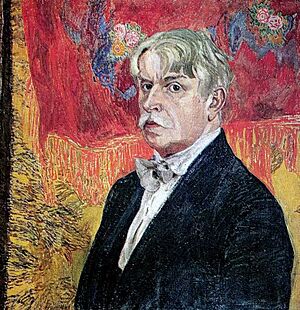Aleksandr Golovin (artist) facts for kids
Quick facts for kids
Aleksandr Golovin
|
|
|---|---|

Self portrait, 1919
|
|
| Born | 1 March 1863 |
| Died | 17 April 1930 (aged 67) |
| Nationality | Russian |
| Known for | Painting, stage design |
Aleksandr Yakovlevich Golovin (born March 1, 1863 – died April 17, 1930) was a famous Russian artist. He was especially known for designing sets and costumes for plays and operas. He worked with important theater directors like Sergei Diaghilev, Constantin Stanislavski, and Vsevolod Meyerhold.
Contents
Early Life and Artistic Journey
Aleksandr Golovin was born in Moscow. He first studied architecture, which is the art of designing buildings. Later, he changed his focus to painting. He also studied art at the Académie Colarossi in Paris.
After finishing his studies, Golovin faced money problems. He worked as a painter and decorator for homes and buildings. He also tried different types of art, like designing furniture. In 1900, he helped design the Russian Empire's building at the 1900 World's Fair in Paris. He worked with his friend K. A. Korovin on this project.
Becoming a Stage Designer
In 1901, Golovin moved from Moscow to the Saint Petersburg area. This is where he truly became famous for his stage designs. He mixed different art styles, like Symbolism and modernism, in his work. He created amazing sets for operas and plays. He designed productions for famous people like Diaghilev and Meyerhold.
After the Revolution of 1917, Golovin found less work in the theater. So, he spent more time on painting and drawing pictures for books.
Designing The Firebird Ballet
Golovin created the set design for the first show of Igor Stravinsky's ballet, The Firebird. This famous ballet first opened in 1910. His designs helped bring the magical story to life on stage.
The Marriage of Figaro at Moscow Art Theatre
Golovin also designed the sets for a very important play called The Marriage of Figaro. This play was shown at the Moscow Art Theatre. The famous Russian theater director, Constantin Stanislavski, directed the play. It opened on April 28, 1927.
Stanislavski changed the play's setting to France before the French Revolution. He also made the play shorter, from five acts to eleven scenes. Golovin used a special spinning stage to make scene changes very quick. The play was a huge success. On its first night, the audience called the actors back to the stage ten times!
Later Life and Legacy
Aleksandr Golovin was given the title of People's Artist of the RSFSR. This was a high honor for artists in Russia. He passed away in Detskoye Selo on April 17, 1930. His work as a painter and especially as a stage designer left a lasting mark on Russian art and theater.
See also
 In Spanish: Aleksandr Golovín (artista) para niños
In Spanish: Aleksandr Golovín (artista) para niños


